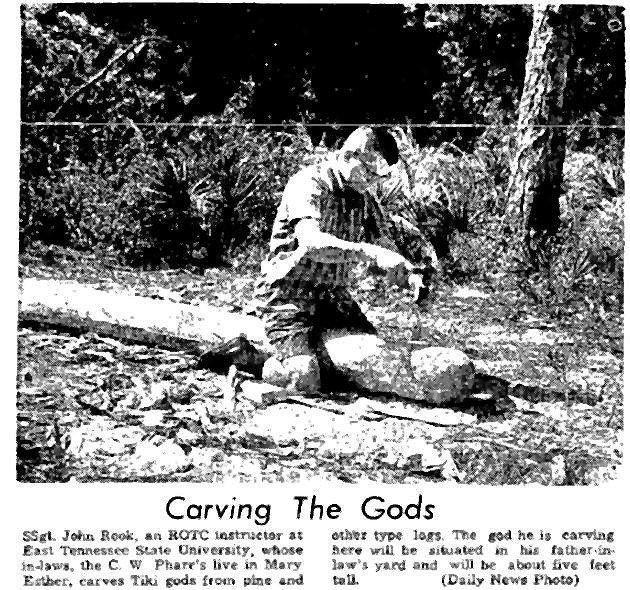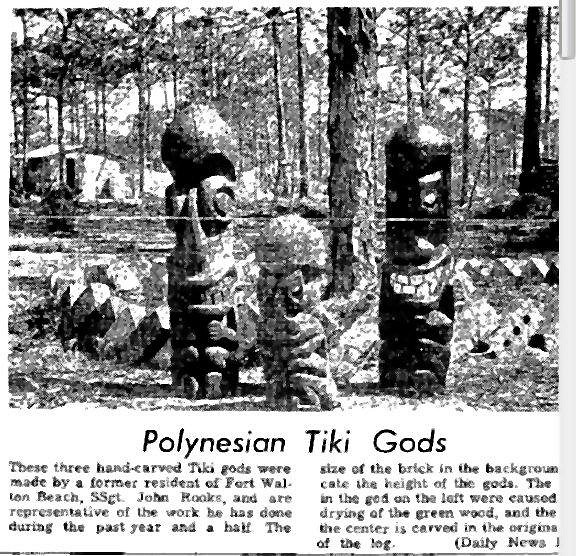P

Joined: Jul 07, 2005
Posts: 1564
|
P

California didn't have every tiki carver. Here's SSgt. John Rook from Tenn.
(from the Playground Daily News, Ft. Walton Beach, Fla., 28 March 1967)


Carving Polynesian Tiki Gods Is Unusual Hobby For Sergeant
By Cherrie Hopkins
DAILY NEWS STAFF
Carving Polynesian Tiki gods
has been the hobby of Staff Sergeant
John Rook, an ROTC ins
t r u c t o r at East Tennessee
State University for the past
year and a half.
The Tiki gods are actually the
embodiment of the male principle
in Polynesian mythology often
depicted as the first man
or superhuman creator of mankind.
Although the Tikis are
called gods, they were not actually
worshipped as idols by the
ancient Polynesians.
Rook, who lived in Fort Walton
Beach before entering the
US Army seven years ago,
learned to carve the gods from
a neighbor in Johnson City,
Tenn. After watching the neighbor
carve a god, Rook set about
to do it for himself. He uses
no design or pattern, but just
carves the gods according to
his mood.
The Rook family has been visiting
the C.W. Pharrs, parents
of his wife Sharon, for a few
weeks. They will be in the Playground
Area until Mar. 31 at
which time they will return to
Tennessee.
The first step in carving a
the felling of a tree. Rook gets
permission from nearby farmers
to cut one of the trees. Many
people have bartered logs for
a Tiki god with the sergeant.
He has made most of his statues
from pine, but now has decided
to use poplar wood whenever
he can get it.
After cleaning the log of bark,
he uses wood chisels to fashion
the features of the gods. In the
year and a half, he estimated
that he has made 30 or 40 of
the gods which vary in size
from a foot tall to about five
feet tall. One of his carvings
is made up of two tiki gods,
one on top of the other, similar
to a totem pole.
The facial features express
the mood of the carver, and
he said that he never knows
exactly how one will look until
he has finished it. The position
of the hands and legs is more
or less the same in all the gods.
After he has carved the Tikis,
he finishes them in various
ways. His favorite finish is a
walnut stain, which gives a
primitive look to the hand-hewn
gods. A green antique kit-provided
an unusual finish for one
of the gods, and his wife is
encouraging him to finish more
of the gods with the antique
kits in various colors. Some people
have asked Rook to carve
the gods and deliver them unfinished,
so that they may complete
the job.
Rook has shown the gods in
art shows, and his work is on
display at the ETSU art museum.
According to the sergeant,
the interest in art in his home
area is great, and the Tiki gods
are a rising interest there. One
woman has asked that he carve
a tiki god of her for a special
purpose — she wants to put her
wig on it
"The thing about these gods
is that they grow on you," the
sergeant said. "I try to give
each a personality, and they are
all different. In fact, I have one
that looks positively wicked."
It takes approximately four
or five hours steady carving to
complete a small god. He doesn't
sand the god, because this
would tone down the rough effect
The only smoothing work
he does is around the head area.
Rook t r i e d varnishing the
gods with clear varnish, but this
didn't work as well as a stain or
a paint. He likes to carve the
gods from fresh, green wood.
When they begin to dry, after
the carving is completed, the
wood cracks, giving the god the
look of antiquity
"I didn't have any trouble in
catching on to the technique of
carving the Tikis," Rook said,
"but it surely causes a lot of
blisters. I have cut myself at
least once for every god I have
carved."
Rook feels that Tiki carving
is definitely a man's hobby, because
of the strength necessary
in pounding and chiseling the
wood.
At the present time he uses
his basement to carve the gods.
His wife is almost as enthusiastic
about his new hobby as he
is. Her only gripe is that she
never has any for herself: people
see them, admire them, and
they are gone. And so goes the
adage about the woodcutter's
wife.
|


